Plan Your Trip
Eat & Drink Like a Local
We love cuisine in Maui because of its tasty exuberance and no-worries embrace of foreign flavors. The plate lunch. Loco moco (rice, fried egg and hamburger patty with gravy). Even Spam musubi (rice ball) has a sassy – if salty – international charm. So join the fun, sample the unknown and savor the next bite.
The Year in Food
Year-round
It's always a good time to dig into produce grown in Maui's Upcountry. Due to the island's consistently warm tropical climate, most fruits and vegetables are harvested year-round.
Spring (April)
Head to Hana to celebrate taro, a unique and revered Hawaiian plant with a starchy potato-like quality. It's used in burgers, chips and mashed into a pastelike pudding called poi.
Fall (October)
To check out the range of produce grown on the island, wander the aisles at the Maui County Fair in early October in Kahului. As Halloween approaches, take the family to the pumpkin patch at Kula Country Farms, where there's also a corn maze.
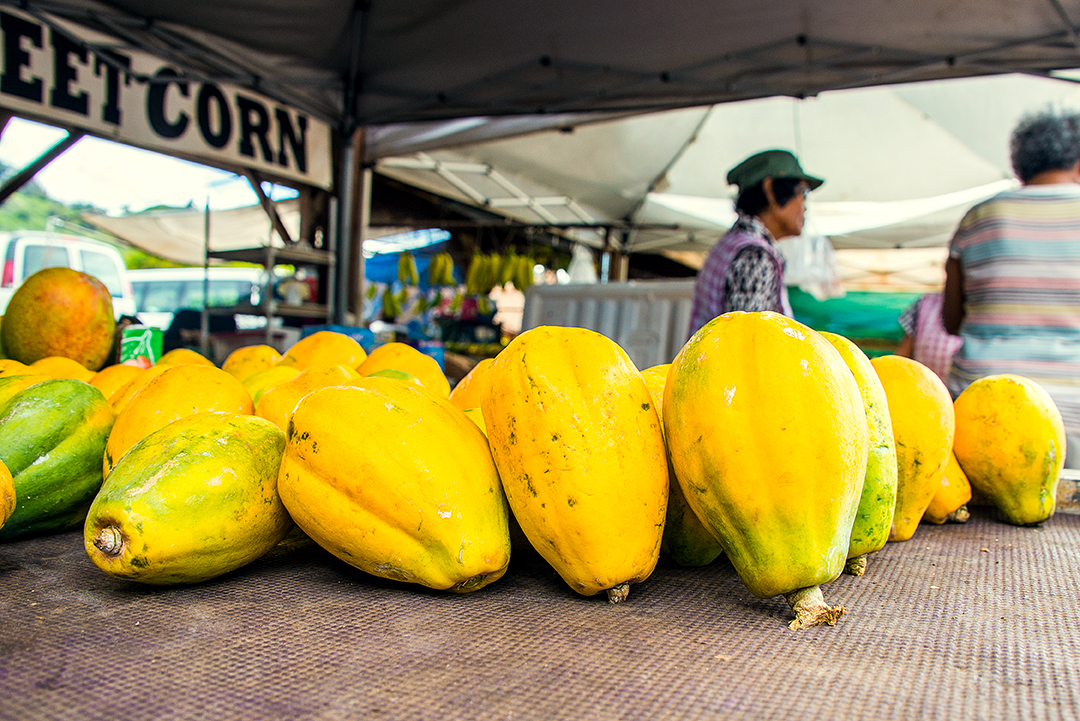
Food Experiences
Meals of a Lifetime
ALahaina Grill Savor seafood and steaks in artsy digs in downtown Lahaina.
AMama's Fish House Celebrate a special occasion with exquisite fish, impeccable service and a prime beach view.
AMonkeypod Kitchen It's your favorite neighborhood restaurant, done Hawaiian-style.
AGeste Shrimp Truck These hot bundles of spicy goodness demand a stack of napkins.
AMana Foods What? An organic grocery? Well, have you tried the deli buffet? Feel the mana at this locals' joint.
AHana Farms Clay Oven Pizza The wood-fired pizzas are loaded with locally grown veggies.
AManaʻe Goods & Grindz Local food that's legendary on Molokaʻi's rural eastern side.
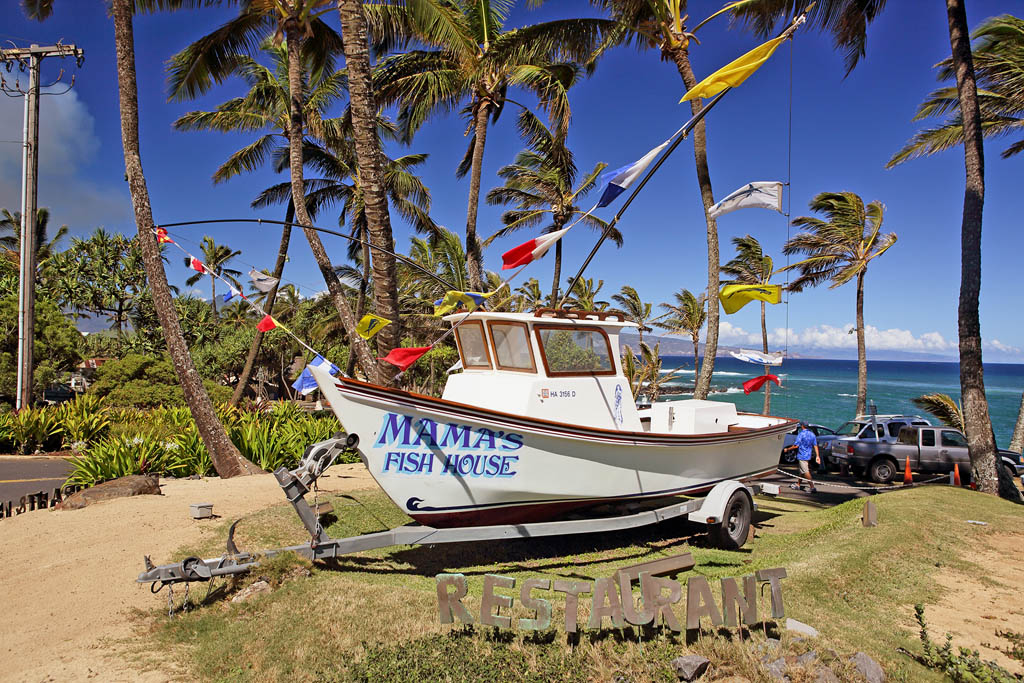
Best Breakfasts
AGazebo Dig into macadamia-nut pancakes beside the Napili coast.
APlantation House Did somebody says crab-cakes Benedict? Oh yes, they did.
AKihei Caffe Quick and hearty is the name of the game at this Kihei hotspot.
AColleen’s Join the surfer crowd for breakfast burritos and egg-stuffed croissants.
A808 Bistro The decadent 'whale pie' encourages gluttony, but the dapper surroundings will keep you polite.
Dare to Try
Spam musubi A rice ball topped with sautéed Spam and wrapped with dried seaweed. Locals of all stripes enjoy this ‘only in Hawaii’ creation.
SPAM A LOT
Spam arrived in Hawaii during WWII, when fresh meat imports were replaced by this standard GI ration. By war’s end, Hawaii had developed a taste for the fatty canned stuff. Today, Hawaii consumes about 7 million cans of Spam annually!
Spam looks and tastes different in Hawaii. It’s eaten cooked (typically sautéed to a light crispiness in sweetened shōyu), not straight from the can, and served as a tasty meat dish.
Local Specialties
Hawaiian food can be divided into three general categories: local food, Native Hawaiian and Hawaii Regional Cuisine.
Local Food
Day-to-day eats reflect the state’s multicultural heritage, with Asian, Portuguese and native Hawaiian influences the most immediately evident. Cheap, fattening and tasty, local food is also the stuff of cravings and comfort. Can be found across the island.
APlate lunch The classic example of local food is the ubiquitous plate lunch. Picture this: chunky layers of tender kalua pork, a dollop of smooth, creamy macaroni and two hearty scoops of white rice. Yum, right? The pork can be swapped for other proteins like fried mahimahi (fish) or teriyaki chicken. Served almost like street food, the plate lunch is often presented on disposable plates and eaten using chopsticks. A favorite breakfast combo includes fried egg and spicy Portuguese sausage (or bacon, ham, Spam etc) and, always, two scoops of rice.
APupu The local term used for all kinds of munchies or ‘grazing’ foods is pupu. Much more than just cheese and crackers, pupu represent the ethnic diversity of the islands and might include boiled peanuts in the shell, edamame (boiled fresh soybeans in the pod) and universal items such as fried shrimp.
APoke Raw fish marinated in shōyu (soy sauce), oil, chili peppers, green onions and seaweed, poke comes in many varieties. Sesame ahi (yellowfin tuna) is particularly delicious and goes well with beer.
AShave ice Ignore joyless cynics who’ll tell you that shave ice is nothing more than a snow cone. Shave ice is not just a snow cone. It’s a tropical 21-gun salute – the most spectacular snow cone on earth. The specifics? The ice is shaved as fine as powdery snow, packed into a paper cone and drenched with sweet fruit-flavored syrups in dazzling hues. For added decadence, add Kauaʻi cream, azuki beans and ice cream.
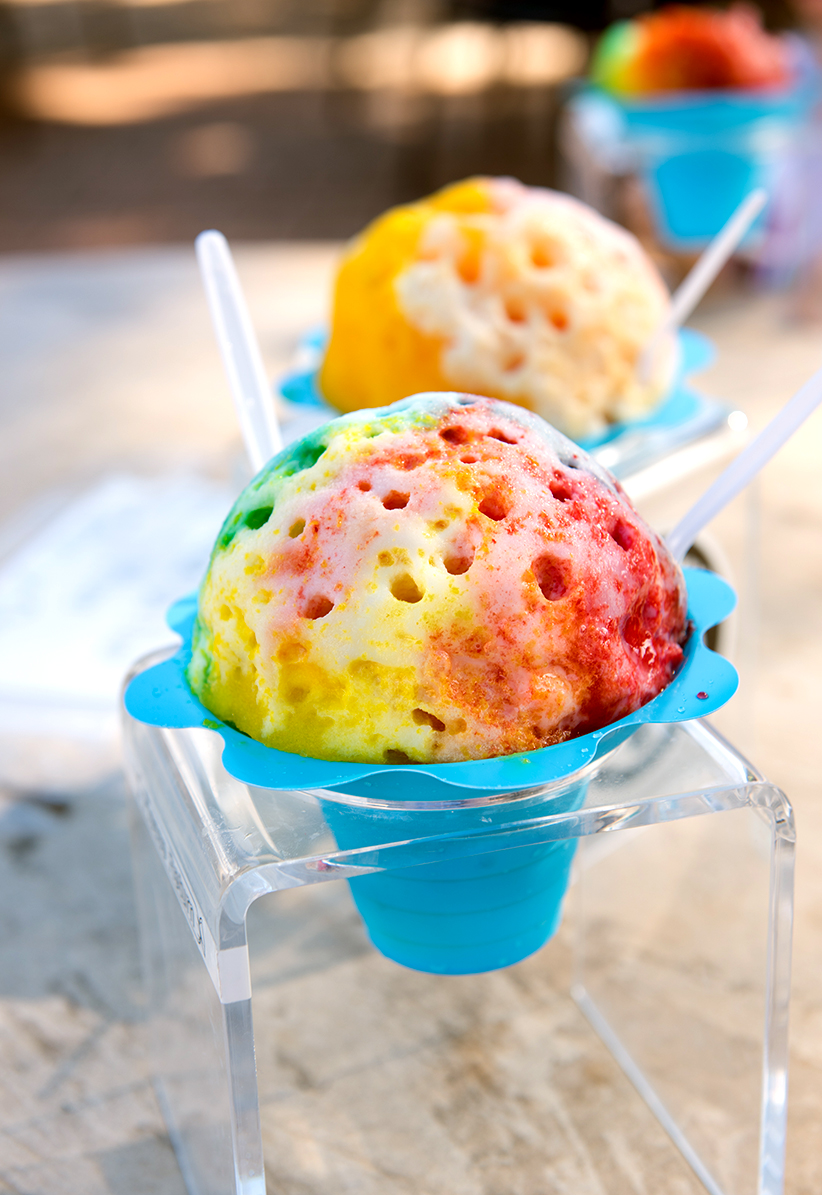
Native Hawaiian
Across Maui you'll find preparation methods and dishes that trace back to the island's first settlers.
AKalua pig and poi These are the ‘meat and potatoes’ of native Hawaiian food. Kalua pork is traditionally baked in an underground oven. Poi is served as the main side dish with every Hawaiian-style meal. The purple paste is pounded from cooked taro roots, with water added to make it puddinglike. It’s nutritious and easily digested, but for many nonlocals it is also an acquired taste, largely because of its pasty consistency.
ALaulau This common main dish is a bundle of pork or chicken and salted butterfish wrapped in a taro leaf that’s steamed until it has a soft spinachlike texture.
ABaked ʻulu Breadfruit which has a texture similar to a potato.
AHaupia This delicious pudding is made of coconut cream thickened with cornstarch or arrowroot. Haupia ice cream made on Maui offers a nice cross between traditional and modern cuisine.
Hawaii Regional Cuisine
Twenty years ago Hawaii was a culinary backwater. Sure, you could slum it on local grinds (food) and get by on the slew of midrange Asian eateries, but fine dining was typically a European-style meal that ignored locally grown fare and the islands' unique flavors.
Then, in the 1990s, a handful of island chefs smashed this tired mold and created a new cuisine, borrowing liberally from Hawaii’s various ethnic influences. They partnered with local farmers, ranchers and fishers to highlight fresh local fare and transform their childhood favorites into grown-up, gourmet masterpieces. The movement was dubbed ‘Hawaii Regional Cuisine’ and the pioneering chefs became celebrities. A trio with Maui connections are Roy Yamaguchi of Roy’s Kaʻanapali, Beverly Gannon of Haliʻimaile General Store and Mark Ellman of Frida's Mexican Beach House, Mala Ocean Tavern and Honu in Lahaina.
The real catchwords for Hawaii Regional Cuisine are fresh, organic and locally grown. Think Upcountry greens, Maui chèvre (goat cheese), Kula onions, free-range Hana beef and locally caught fish. The spread of the movement has been a boon to small-scale farmers who are contributing to a greening of Maui’s gardens and menus.
How to Eat & Drink
When to Eat
Maui locals eat meals early and on the dot. Restaurants are packed around the habitual mealtimes, but they clear out an hour or two later, as locals are not lingerers. If you dine at 8:30pm you might not have to wait at all. But bear in mind that restaurants also close early and night owls must hunt for places to eat.
ABreakfast Typically 6am for the day's first meal.
ALunch Noon.
ADinner Locals eat at 6pm.
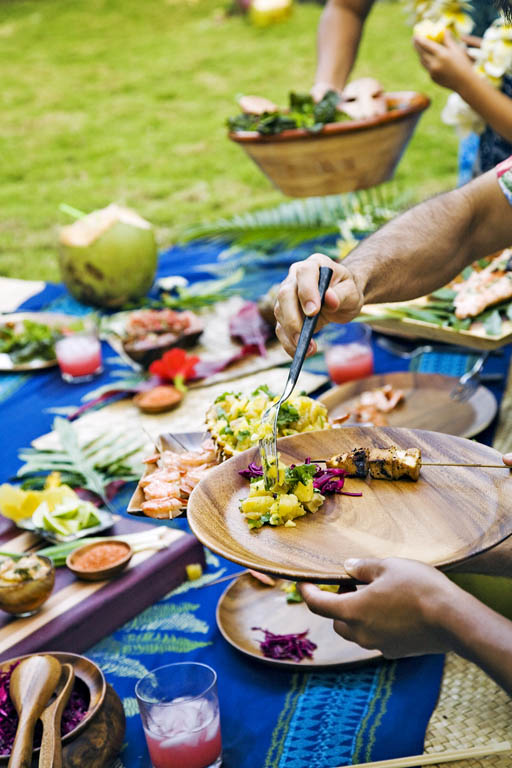
Where to Eat
For top-end restaurants in Maui, book a week in advance, and earlier during the winter holiday season.
APlate-lunch eateries Great choices for quick takeout. They pack things tidily so you can carry your meal to a nearby beach for an impromptu picnic lunch. One tip: at lunchtime, decide what you want before reaching the register. Lines typically move quickly and the indecisive can muck up the system.
AFood trucks Known as kaukau (food) wagons, food trucks have become common on Maui. They typically park near the beach or shopping centers. Bring cash.
ACafes These are the best places to relax over a good lunch in an engaging setting at a fair price. If the setting isn’t important, there are plenty of diner-style Asian restaurants with Formica tables and vinyl chairs, no view and no decor. They generally offer quick service and often have surprisingly good food at decent prices.
ATop-end restaurants These are outright impressive and include some of the most highly rated chef-driven places in Hawaii. These establishments are typically found on prime oceanfront perches as well as in resorts and golf-course clubhouses. Most forgo the pompous fastidiousness common to upscale urban restaurants on the US mainland. Meals start at $30 per person. To sample top cuisine at a good price, visit during happy hour when prices of appetizers are often reduced.
AGroceries Chains and locally owned markets can be found across the island. You'll find local specialties like poke bowls and Spam musubi at most of them.
AFarmers markets & produce stands Local farms and food purveyors share their fare at kiosk-lined farmers markets in West Maui, Central Maui, South Maui and the Upcountry. Most farmers markets occur once per week. Fruit and farm stands are common along the Road to Hana, in Hana and in Kula. As of 2013, about 90% of groceries were imported to Hawaii from the mainland, including milk, fruit, vegetables and beef. If absolute freshness matters to you, choose locally raised beef, island-caught fish and Maui-grown produce.

Price Ranges
The following price ranges refer to a standard main on Maui. Prices don’t include tax.
$ less than $15
$$ $15–25
$$$ more than $25
Habits & Customs
AFood portions Locals tend to consider quantity as important as quality – and the portion sizes are telling, especially at plate-lunch places. If you’re a light eater, feel free to split a meal or take home the leftovers.
APotluck meals Home entertainment for local folks always revolves around food, which is usually served ‘potluck style’ with all the guests adding to the anything-goes smorgasbord. Locals rarely serve dinner in one-at-a-time courses. Rather, meals are served ‘family style,’ where diners help themselves. Throwaway paper plates and wooden chopsticks make for an easy clean-up, and the rule is ‘all you can eat’ (and they definitely mean it!).
ADinner guest If you’re invited to someone’s home, show up on time and bring a dish – preferably homemade, but a bakery cake or manju (Japanese cakes filled with sweet bean paste) from Sam Sato’s in Wailuku are always a certain hit. Remove your shoes at the door. And don’t be surprised if you’re forced to take home a plate of leftovers.
Menu Decoder
You'll find a few staples in just about every Hawaiian meal. One word of caution: Maui’s attempts at nonlocal classics such as pizza, bagels, croissants and southern BBQ can be disappointing. Stick with local-local food.
ASticky white rice More than just a side dish in Hawaii, sticky white rice is a culinary building block, an integral partner in everyday meals. Without rice, Spam musubi would be a slice of canned meat. Loco moco would be nothing more than an egg-covered hamburger. And without two-scoop rice, the plate lunch would be a ho-hum conversation between meat and macaroni rather than a multicultural party. And by the way, sticky white rice means sticky white rice. While you might find couscous or mashed potatoes at fancy restaurants, day-to-day meals are served with sticky white rice. Not flaky rice. Not wild rice. Not flavored rice. And definitely not Uncle Ben’s. Locals can devour mounds of the stuff and it typically comes as two scoops. The top condiment is soy sauce, known by its Japanese name shōyu, which combines well with sharp Asian flavors such as ginger, green onion and garlic.
AProtein Meat, chicken or fish are often key components of a meal, too. For quick, cheap eating, locals devour anything tasty, from Portuguese sausage to hamburger steak to corned beef. But the dinner-table highlight is always seafood, especially freshly caught fish.
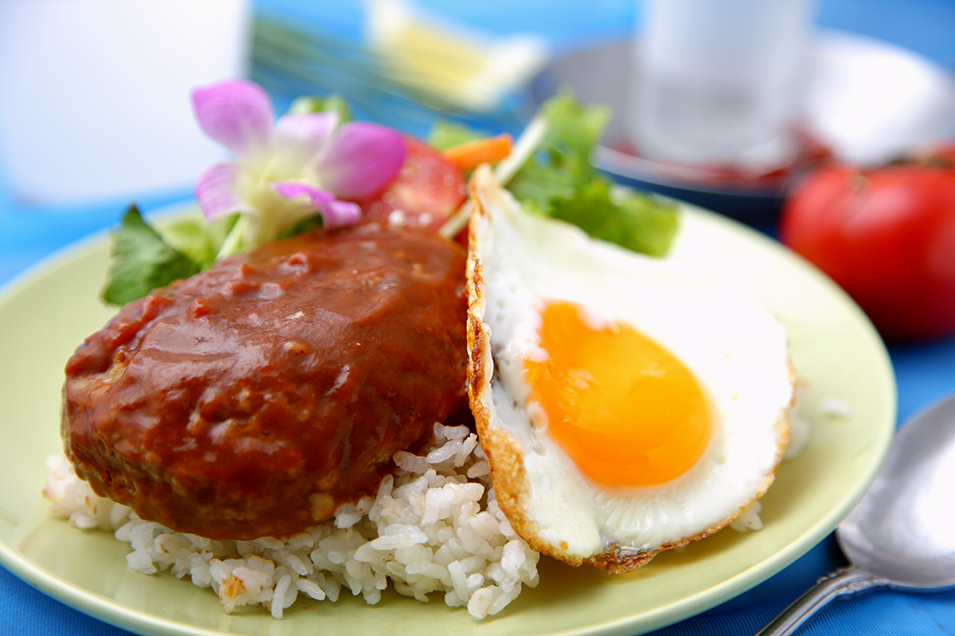
FOOD GLOSSARY
Hawaii's cuisine is multiethnic and so is the lingo.
adobo – Filipino chicken or pork cooked in vinegar, shōyu, garlic and spices
ʻawa – kava, a Polynesian plant used to make a mildly intoxicating drink
bentō – Japanese-style box lunch
broke da mout – delicious; literally 'broke the mouth'
char siu – Cantonese barbecued pork
chirashizushi – assorted sashimi served over rice
crack seed – Chinese-style preserved fruit; a salty, sweet and/or sour snack
donburi – Japanese-style large bowl of rice topped with a protein (eg pork katsu)
furikake – catch-all Japanese seasoning or condiment, usually dry and sprinkled atop rice; in Hawaii, sometimes mixed into poke
grind – to eat
grinds – food (usually local)
guava – fruit with green or yellow rind, moist pink flesh and lots of edible seeds
haupia – coconut-cream custard, often thickened with arrowroot or cornstarch
hulihuli chicken – rotisserie-cooked chicken with island-style barbecue sauce
imu – underground earthen oven used to cook kalua pig and other luau food
ʻinamona – roasted, ground kukui (candlenut), used as a condiment (eg mixed into poke)
izakaya – Japanese pub serving tapas-style dishes
kalbi – Korean-style grilled meats, typically marinated short ribs
kalo – Hawaiian word for taro, often pounded into poi
kalua – Hawaiian method of cooking pork or other luau food, traditionally in an imu
kare-kare – Filipino oxtail stew
katsu – Japanese deep-fried cutlets, usually pork or chicken
kaukau – food
laulau – bundle of pork or chicken and salted butterfish, wrapped in taro and ti leaves and steamed
li hing mui – sweet-salty preserved plum, a type of crack seed; also refers to the flavor powder
lilikoʻi – passion fruit
loco moco – hearty dish of rice, fried egg and hamburger patty topped with gravy or other condiments
lomilomi salmon – minced, salted salmon with diced tomato and green onion
luau – Hawaiian feast
mai tai – tiki-bar drink typically containing rum and tropical fruit juices
malasada – sugar-coated, fried Portuguese doughnut (no hole), often filled with flavored custard
manapua – Chinese bao (baked or steamed buns) with char siu or other fillings
manjū – Japanese steamed or baked cake, often filled with sweet bean paste
mochi – Japanese pounded-rice cake, sticky and sweet
musubi – Japanese onigiri (rice ball or triangle) wrapped in nori
noni – type of mulberry with strong-smelling yellow fruit, used medicinally by Hawaiians
nori – Japanese seaweed, usually dried
ogo – crunchy seaweed, sometimes added to poke; limu in Hawaiian
okazu-ya – Japanese take-out delicatessen, often specializing in home-style Hawaiian and local dishes
ʻono – delicious
ʻono kine grinds – good food
pau hana – happy hour (literally 'stop work')
pipikaula – Hawaiian beef jerky
poha – cape gooseberry
poi – staple Hawaiian starch made of steamed, mashed taro (kalo)
poke – cubed, marinated raw fish
ponzu – Japanese citrus sauce
pupu – snacks or appetizers
saimin – local-style noodle soup
shave ice – cup of finely shaved ice doused with sweet syrups
shōyu – soy sauce
star fruit – translucent green-yellow fruit with five ribs like the points of a star, and sweet, juicy pulp
taro – plant with edible corm used to make poi and with edible leaves to wrap around laulau; kalo in Hawaiian
uni – sea urchin